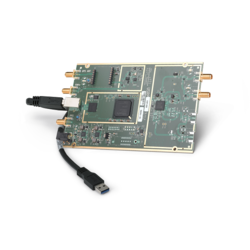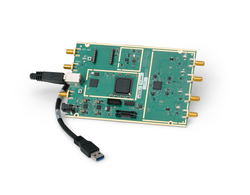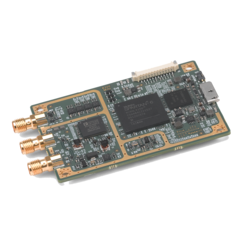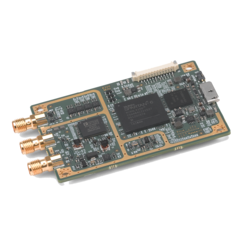B200/B210/B200mini/B205mini
Contents
- 1 Device Overview
- 2 Key Features
- 3 Frontend Specifications
- 4 RF Specifications
- 5 Hardware Specifications
- 6 Physical Specifications
- 7 Environmental Specifications
- 8 Schematics
- 9 Key Component Datasheets
- 10 Mechanical Information
- 11 Enclosures
- 12 FPGA
- 13 Interfaces and Connectivity
- 14 Certifications
- 15 Certificate of Volatility
- 16 Downloads
- 17 FAQ
Device Overview
The USRP Bus Series provides a fully integrated, single board, Universal Software Radio Peripheral platform with continuous frequency coverage from 70 MHz – 6 GHz. Designed for low-cost experimentation, it combines a fully integrated direct conversion transceiver providing up to 56MHz of real-time bandwidth, an open and reprogrammable Spartan6 FPGA, and fast and convenient bus-powered SuperSpeed USB 3.0 connectivity.
Key Features
B200
|
B210
|
B200mini
|
B200mini-i
|
B205mini-i
|
Frontend Specifications
Tuning
The RF frontend has individually tunable receive and transmit chains. On the B200 and B200 mini, there is one transmit and one receive RF frontend. On the B210, both transmit and receive can be used in a MIMO configuration. For the MIMO case, both receive frontends share the RX LO, and both transmit frontends share the TX LO. Each LO is tunable between 50 MHz and 6 GHz.
Gains
All frontends have individual analog gain controls. The receive frontends have 73 dB of available gain; and the transmit frontends have 89.5 dB of available gain. Gain settings are application specific, but it is recommended that users consider using at least half of the available gain to get reasonable dynamic range.
Bandwidths
The analog frontend has a seamlessly adjustable bandwidth of 200 kHz to 56 MHz.
Generally, when requesting any possible master clock rate, UHD will automatically configure the analog filters to avoid any aliasing (RX) or out-of-band emissions whilst letting through the cleanest possible signal.
If you, however, happen to have a very strong interferer within half the master clock rate of your RX LO frequency, you might want to reduce this analog bandwidth. You can do so by calling uhd::usrp::multi_usrp::set_rx_bandwidth(bw).
The property to control the analog RX bandwidth is bandwidth/value.
UHD will not allow you to set bandwidths larger than your current master clock rate.
RF Specifications
The USRP B200/B210/B200mini/B205mini are derived from the Analog devices AD936x integrated transceiver chip, the overall RF performance of the device is largely governed by the transceiver chip itself.
RF Performance
- SSB/LO Suppression -35/50 dBc
- Phase Noise 3.5 GHz 1.0 deg RMS
- Phase Noise 6 GHz 1.5 deg RMS
- Power Output >10dBm
- IIP3 (@ typ NF) -20dBm
- Typical Noise Figure <8dB
- Maximum Input Power: 0 dBm
RF Performance Data
B200mini / B205mini
B200 / B210
Hardware Specifications
- Ettus Research recommends to always use the latest stable version of UHD
B200
- Current Hardware Revision: 6
- Minimum version of UHD required: 3.8.4
- B200 Rev 5 (AD9364-based board) requires minimum UHD 3.8.4
B210
- Current Hardware Revision: 5
- Minimum version of UHD required: 3.6.0
B200mini
- Current Hardware Revision: 2
- Minimum version of UHD required: 3.9.0
B200mini-i
- Current Hardware Revision: 2
- Minimum version of UHD required: 3.9.0
B205mini-i
- Current Hardware Revision: 1
- Minimum version of UHD required: 3.9.2
Physical Specifications
Dimensions
- B200mini/B205mini 5.0 x 8.4 cm
- B200/B210 9.7 x 15.5 x 1.5 cm
Environmental Specifications
Operating Temperature Range
- B200mini / B200 / B210 0-40 °C
- B200mini-i / B205mini-i 0-45 °C
Operating Humidity Range
- 10% to 90% non-condensing
Schematics
B200mini/B200mini-i/B205mini-i
B200mini/B200mini-i/B205mini-i Schematics
B200/B210
Key Component Datasheets
| Part Number | Description | Schematic ID (Page) |
|---|---|---|
| Analog Devices AD9364 | RF Transceiver | U1 (2) |
| Analog Devices AD9361 | RF Transceiver | U2 (2,8) |
| AD9361/AD9364 Product Page | RF Transceiver | - |
| Xilinx Spartan-6 Product Page | FPGA | U1 (2,3,4,6); PG1 (6); U18B, U18C (7); U18D (8); U18E, U18F (9); U18G, U18H (10) |
| XC6SLX75 / XC6SLX150 | FPGA | |
| ADF4001 | Frequency Synthesizer | U101 (1) |
| CYUSB3014 | FX3: SuperSpeed USB Controller | U3 (5,6); U13 (5) |
| EZ-USB FX3™ Product Page | ||
| SKY13317 | Antenna Switch | U801, U810 (8) |
| BD3150L50100A00 | Balun | U802, U808, U809, U815 (8) |
| PGA−102+ | Amplifier | U804, U817 (8) |
| B200mini VXTCXO | VXTCXO (B200mini only) | - |
| M9107 | Optional GPSDO (B200/B210 only) | U100 (1) |
Mechanical Information
Weight
- B200mini 24.0 g
- B200/B210 350 g
Drawings
B200mini
B200
B210
Enclosures
- Full Steel Enclosure
- Compatible with green USRP B200 and B210 devices (revision 6 or later)
- Front and rear K-Slots for anti-theft protection
FPGA
- Utilization statistics are subject to change between UHD releases. This information is current as of UHD 3.9.4 and was taken directly from Xilinx Vivado 2014.4.
B200
Device utilization summary:
---------------------------
Selected Device : 6slx75fgg484-3
Slice Logic Utilization:
Number of Slice Registers: 15781 out of 93296 16%
Number of Slice LUTs: 19987 out of 46648 42%
Number used as Logic: 15983 out of 46648 34%
Number used as Memory: 4004 out of 11072 36%
Number used as RAM: 972
Number used as SRL: 3032
Slice Logic Distribution:
Number of LUT Flip Flop pairs used: 24062
Number with an unused Flip Flop: 8281 out of 24062 34%
Number with an unused LUT: 4075 out of 24062 16%
Number of fully used LUT-FF pairs: 11706 out of 24062 48%
Number of unique control sets: 434
IO Utilization:
Number of IOs: 172
Number of bonded IOBs: 155 out of 280 55%
IOB Flip Flops/Latches: 124
Specific Feature Utilization:
Number of Block RAM/FIFO: 144 out of 172 83%
Number using Block RAM only: 144
Number of BUFG/BUFGCTRLs: 4 out of 16 25%
Number of DSP48A1s: 76 out of 132 57%
B210
Device utilization summary:
---------------------------
Selected Device : 6slx150fgg484-3
Slice Logic Utilization:
Number of Slice Registers: 29310 out of 184304 15%
Number of Slice LUTs: 36486 out of 92152 39%
Number used as Logic: 29279 out of 92152 31%
Number used as Memory: 7207 out of 21680 33%
Number used as RAM: 1752
Number used as SRL: 5455
Slice Logic Distribution:
Number of LUT Flip Flop pairs used: 43635
Number with an unused Flip Flop: 14325 out of 43635 32%
Number with an unused LUT: 7149 out of 43635 16%
Number of fully used LUT-FF pairs: 22161 out of 43635 50%
Number of unique control sets: 723
IO Utilization:
Number of IOs: 180
Number of bonded IOBs: 163 out of 338 48%
IOB Flip Flops/Latches: 148
Specific Feature Utilization:
Number of Block RAM/FIFO: 186 out of 268 69%
Number using Block RAM only: 186
Number of BUFG/BUFGCTRLs: 4 out of 16 25%
Number of DSP48A1s: 152 out of 180 84%
B200mini
Device utilization summary:
---------------------------
Selected Device : 6slx75csg484-3
Slice Logic Utilization:
Number of Slice Registers: 15949 out of 93296 17%
Number of Slice LUTs: 19963 out of 46648 42%
Number used as Logic: 16140 out of 46648 34%
Number used as Memory: 3823 out of 11072 34%
Number used as RAM: 972
Number used as SRL: 2851
Slice Logic Distribution:
Number of LUT Flip Flop pairs used: 23859
Number with an unused Flip Flop: 7910 out of 23859 33%
Number with an unused LUT: 3896 out of 23859 16%
Number of fully used LUT-FF pairs: 12053 out of 23859 50%
Number of unique control sets: 429
IO Utilization:
Number of IOs: 123
Number of bonded IOBs: 114 out of 328 34%
IOB Flip Flops/Latches: 147
Specific Feature Utilization:
Number of Block RAM/FIFO: 110 out of 172 63%
Number using Block RAM only: 110
Number of BUFG/BUFGCTRLs: 6 out of 16 37%
Number of DSP48A1s: 76 out of 132 57%
Number of PLL_ADVs: 1 out of 6 16%
B205mini
Device utilization summary:
---------------------------
Selected Device : 6slx150csg484-3
Slice Logic Utilization:
Number of Slice Registers: 15949 out of 184304 8%
Number of Slice LUTs: 19963 out of 92152 21%
Number used as Logic: 16140 out of 92152 17%
Number used as Memory: 3823 out of 21680 17%
Number used as RAM: 972
Number used as SRL: 2851
Slice Logic Distribution:
Number of LUT Flip Flop pairs used: 23859
Number with an unused Flip Flop: 7910 out of 23859 33%
Number with an unused LUT: 3896 out of 23859 16%
Number of fully used LUT-FF pairs: 12053 out of 23859 50%
Number of unique control sets: 429
IO Utilization:
Number of IOs: 123
Number of bonded IOBs: 114 out of 338 33%
IOB Flip Flops/Latches: 147
Specific Feature Utilization:
Number of Block RAM/FIFO: 110 out of 268 41%
Number using Block RAM only: 110
Number of BUFG/BUFGCTRLs: 6 out of 16 37%
Number of DSP48A1s: 76 out of 180 42%
Number of PLL_ADVs: 1 out of 6 16%
Interfaces and Connectivity
B200/B210/B200mini - USB 3.0
GPIO
Power on state
The hardware power on state and UHD initial state for the front-panel GPIOs is high-Z. For the B2xx, B2xxmini there are no external pull-ups/pull-downs for the GPIO pins, but the FPGAs do have them and they are configured as follows: B2xx: pull-up, B2xxmini: pull-up.
Timing Reference Input
B200mini/B200mini-i/B205mini-i
- 1-PPS or 10 MHz input
1-PPS
- Maximum: -5V / +5V
- Minimum: 0V / +2.5V
10 MHz
- Maximum: 0V / +5V
- Minimum: 0V / +1.8V
OR
- +10dBm ~ +27dBm
B200/B210
1-PPS
- Maximum: 5V
10 MHz
- Maximum: 15dBm (3.5V into 50 ohms)
Certifications
RoHS
As of December 1st, 2010 all Ettus Research products are RoHS compliant unless otherwise noted. More information can be found at http://ettus.com/legal/rohs-information
China RoHS
Management Methods for Controlling Pollution Caused by Electronic Information Products Regulation
Chinese Customers National Instruments is in compliance with the Chinese policy on the Restriction of Hazardous Substances (RoHS) used in Electronic Information Products. For more information about the National Instruments China RoHS compliance, visit ni.com/environment/rohs_china.
Certificate of Volatility
B200/B210
Downloads
FAQ
This is a list of frequently asked questions on the USRP B200/B210/B200mini. If you have questions that are not answered in this document, please contact us - info@ettus.com.
Will the USRP B200/B210 work with USB 2.0?
Yes, both the USRP B200 and USRP B210 will fall back to the USB 2.0 standard if a USB 3.0 port is not available. There are several things to consider. First, the USB 2.0 data rates are slower. Depending on the USB controller, operating system, and other factors, you may achieve a sample rate up to 8 MS/s with USB 2.0. Also, you may not be able to bus-power the USRP B200/B210 in USB 2.0 mode.
What samples rates should I expect with USB 3.0? USB 2.0?
USB 3.0 is a new standard, and there seems to be wide variation in throughput across various USB 3.0 controllers. Ettus Research maintains a list of benchmarks for various operating systems and USB 3.0 controllers.
When can I power the USRP B200/B210/B200mini off the USB bus?
The experience may vary across various controllers. Generally speaking, bus-power is ideal for SISO operation. If you are using both channels of a USRP B210 we recommend an external power supply. We provide a power supply with the USRP B210.
MIMO operation with the USRP B210 is not recommended when using the USRP B210 on bus-power.
You should not attempt to run the device on bus-power if a GPS-disciplined oscillator is installed.
How much power does the USRP consume?
The table below shows power consumption (Watts) of a USRP B210 run with a 6V power supply. Figures on a 5V supply (USB power), or with a USRP B200 will be moderately lower. The sample rates shown are aggregate sample rates on the USB 3.0 interface.
| 5 Msps | 15.36 Msps | 30.72 Msps | 56 Msps | 61.44 Msps | |
|---|---|---|---|---|---|
| 1 RX | 1.92 | 2.112 | 2.184 | 2.508 | |
| 2 RX | 2.148 | 2.436 | 2.508 | 2.64 | |
| 1 TX | 2.184 | 2.34 | 2.352 | 2.22 | |
| 2 TX | 2.76 | 2.88 | 2.904 | 2.64 | |
| Full Duplex (1x1) | 2.508 | 2.736 | 2.796 | 3.168 | |
| 2x2 MIMO | 3.252 | 3.588 | 3.672 | 4.11 | 4.092 |
Can I build a multi-unit system with the USRP B200/B210?
It is possible to synchronize multiple USRP B200/B210 devices using the 10 MHz/1 PPS inputs and an external distribution system like to the OctoClock-G. However, USB 3.0/2.0 performance varies dramatically when multiple devices are streaming through the same controller. Generally, we recommend using the USRP N200/N210 if you need to build a high-channel count system.
Can I access the source code for the USRP B200/B210?
Yes. The USRP B200/B210 is supported by the USRP Hardware DriverTM software. You can find the driver and FPGA source code for the USRP B200/B210, and all other USRP models, in the UHD git repository:
http://files.ettus.com/manual/page_build_guide.html
What operating systems does the USRP B200/B210 work on?
The USRP B200/B210 is supported on Linux, MAC and Windows.
Does the USRP B200/B210 work with GNU Radio?
Yes. The USRP B200/B210 work with our GNU Radio plugin - gr-uhd.
Does the USRP B200/B210 work with MATLAB and Simulink?
Yes. You need to install the Communications System Toolbox Support Package for USRP Radio.
Does the USRP B200/B210 work with OpenBTS?
Yes. This is a third-party application and you can find instructions here: OpenBTS - Build, Install, Run.
For support, please sign up and contact the OpenBTS mailing list.
What tools do I need to program the FPGA?
The USRP B200 and USRP B210 include a Spartan 6 XC6SLX75 and XC6S150, respectively. The USRP B200 can be programmed with the free version of Xilinx tools, while the larger FPGA on the USRP B210 requires a licensed seat.
Can I use a GPSDO with the USRP B200/B210?
Ettus Research offers a Board-Mounted GPS-Disciplined OCXO and a Board-Mounted GPS-Disciplined TCXO, which are compatible with the USRP B200/B210. These provide a high-accuracy XO, which can be disciplined to the global GPS standard. Please note: When the GPSDO OCXO model is integrated on the USRP B200/B210, the device should be powered with an external supply instead of USB bus power. The TCXO version can be USB bus powered.




